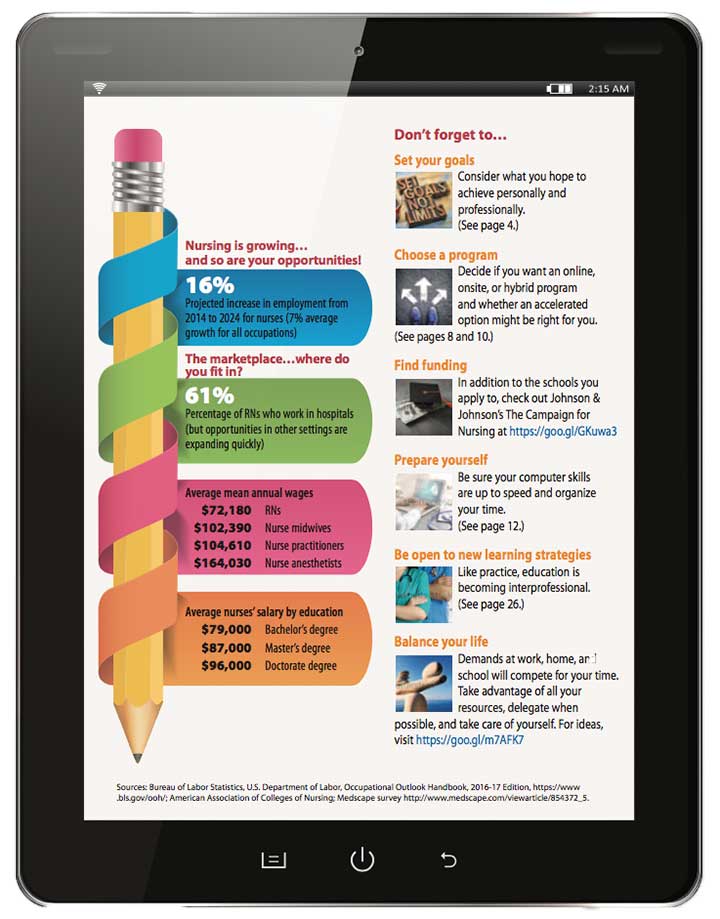Clinical rotations are the mainstay of basic nursing programs. The traditional model calls for one clinical instructor to eight students. Although still used, this model has several drawbacks: Many educational programs are competing for clinical placements, a faculty shortage exists, and many students believe they’re not getting adequate clinical preparation.
A newer model of clinical nursing education—the dedicated education unit (DEU)—helps overcome these drawbacks. Originating in Australia in the 1990s, the DEU is an innovative way to educate tomorrow’s nurses. It has been adopted in New Zealand and is gaining popularity in the United States.
Understanding the DEU model
In the DEU model, academic institutions and healthcare organizations join as partners to offer nursing students a unique clinical experience. The basic tenets are peer teaching, collaboration between educators and clinical service providers to enhance student learning, and improved clinical experiences. The goals of the DEU model are to:
- enhance collaboration between nursing academia and professional practice
- encourage students to apply theory to practice, using professional nursing staff as clinical preceptors
- increase learning opportunities by immersing students in the nursing role
- expose staff nurses to the educator role as a way to address the faculty shortage.
Experienced nurses volunteer as preceptors for student nurses throughout their clinical rotation. In practice, the DEU model varies somewhat, but it always involves close collaboration between academic and clinical organizations.
The model begins with the student’s first hospital or clinical rotation. Ideally, all further clinicals (not just the senior-year capstone project) use the DEU model. Students may complete all of their clinicals at one facility (as hospitals prefer), but some may choose not to. Students go on their clinical rotations as a group; each student pairs with his or her preceptor. Although a clinical instructor is available on site, students work directly with their preceptors throughout the semester. For example, they assess patients, provide care, and administer medications with their preceptors, not their instructors.
The DEU model must be planned carefully, starting with a clear description of the roles and responsibilities of clinical faculty, clinical preceptors, nurse managers, and students. A clinical faculty member facilitates the experience.
Current research findings on the DEU model are favorable. Students and preceptors report increased satisfaction levels, including student satisfaction with preceptors and clinical faculty. Students also feel more welcomed by the staff, which enhances their engagement. Such studies support continued DEU development and implementation, along with research on this model.
To help nurses, educators, and administrators learn about the DEU model, this article describes a DEU model that has been implemented in two organizations in New York state. We’ll call them Organization A and Organization B.
Pilot programs
The authors of this article developed pilot programs for both organizations. In Organization A, the DEU originally was piloted with junior-level medical-surgical baccalaureate students in 2010 and with senior-level students in 2011. In Organization B, the DEU was piloted in 2012. Although both organizations used similar DEU models, they tailored them to their students’ levels (junior vs. senior) and to meet the organization’s own needs.
Initially, students were paired with one clinical preceptor. Preceptors were chosen by the nurse manager based on their interest, preceptor workshop completion, and commitment for the semester. To prepare them for their role, preceptors were offered a workshop on the following topics:
- differences between the DEU and traditional models
- benefits of the DEU model
- overview of the nursing curriculum and student learning objectives for the clinical rotation
- each member’s roles and responsibilities.
Although the clinical faculty member is responsible for formative and summative evaluations, ongoing collaboration between the clinical faculty member and clinical preceptor must occur. When the DEU model was implemented at the senior level, two students were assigned to one clinical preceptor. In a recent change to the DEU model at Organization B, two preceptors now share the role. Also, faculty members hold formal meetings and give presentations to the nursing staff on topics of their choice.
DEU outcomes
Our initial findings yielded several interesting outcomes for both students and preceptors: a realistic view of what nursing is really like, enjoyment of a one-to-one relationship between the preceptor and student, and growth and learning. Preceptors reported that working with students in this manner sharpened their clinical skills. They found themselves returning to the literature to explain the rationale for procedures, nursing interventions, and collaborative care.
Students reported the DEU model helped them integrate theoretical knowledge with clinical practice and offered greater immersion in the professional nursing role than the traditional model did. Overall, students voiced increased satisfaction with the DEU model and strongly recommended its continuation.
Faculty reported students showed greater engagement with patients. Instead of having to wait for faculty to become available, students could participate with their preceptors in administering nursing care, changing dressings, and giving medications. They also noted students were able to engage in interdisciplinary rounds, quality-improvement projects, patient education, discharge planning, and responding to unplanned events (for instance, a patient newly placed on isolation measures).
Faculty had more time to spend with individual students, including reviews of physical assessment findings and patient charts, and they could better determine each student’s understanding of the care he or she was delivering. Also, faculty reported students were using time-management and organizational skills in real clinical scenarios.
The dean at the academic institution involved in these DEU pilot programs fully supports the DEU model and asserts that the groundwork for the DEU must be laid at the administration level. To enhance collaboration between faculty and staff, she recommends selecting faculty members who are familiar with the hospital that’s hosting the clinical rotation and who are known to hospital administrators. When visiting units, she noted students were fully engaged in patient care. She received positive feedback from students, who told her they believe they’re doing the work of nursing, as well as from managers, who credit the DEU with raising the level of professional practice.
At Organization B, the nurse manager observed that the DEU model created a positive work and learning environment for staff and students. Students became engaged in a faster-paced, stimulating learning environment that allowed staff to impart their knowledge and experience. (See Lessons learned.)
What the future may hold
Initial evaluation of the DEU model has been positive. Further development and research are needed to ensure best practices and positive student outcomes. We strongly recommend expanding this program so all nursing students can have at least one DEU experience. As an added benefit, the DEU model helps recruit new graduates. Organization B has hired six former DEU students, who already are acclimated to the hospital. We believe implementing a DEU can benefit all nursing education programs and healthcare service organizations.
References
Hannon PO, Hunt CA, Haleem D, King L, Day L, Casals P. Implementation of a Dedicated Education Unit for baccalaureate students: process and evaluation. Int J Nurs Ed. 2012;4(2):155-9.
Harmon LM. Rural model dedicated education unit: partnership between college and hospital. J Contin Educ Nurs. 2013;44(2):89-96.
McKown T, McKeon L, Webb S. Using quality and safety education for nurses to guide clinical teaching on a new dedicated education unit. J Nurs Educ. 2011;50(12):706-10.
Miller TW. The dedicated education unit; a practice and education partnership. Nurs Leadersh Forum. 2005;9(4):169-73.
Moore J, Nahigian E. Nursing student perceptions of nurse-to-nurse collaboration in dedicated education units and in traditional clinical instruction units. J Nurs Educ. 2013; 52(6):346-50.
Mulready-Shick J, Flanagan KM, Baniser GE, Mylott L, Curtin LJ. Evaluating dedicated education units for clinical education quality. J Nurs Educ. 2013;52(11):606-14.
Murray TA, James DC. Evaluation of an academic service partnership using a strategic alliance framework. Nurs Outlook. 2012;60(4):e17-22.
Rhodes ML, Meyers CC, Underhill ML. Evaluation outcomes of a dedicated education unit in a baccalaureate nursing program. J Prof Nurs. 2012;28(4):223-30.
Shake EE. Dedicated Education Units: Do They Improve Student Satisfaction? [e-book]. University of South Carolina; 2010.
Tuohy C. Collaborative work with industry: implementation of dedicated education units. Whitireia Nurs J. 2011;18:25-38.
The authors work in the School of Nursing at the College of New Rochelle in New Rochelle, New York. Deborah A. Hunt is an assistant professor of nursing and course coordinator. Mary F. Milani is a clinical instructor. Susan Wilson is an assistant clinical professor.
Read a letter to the Editor here.



















2 Comments.
Thanks helpful information
Thanks great information